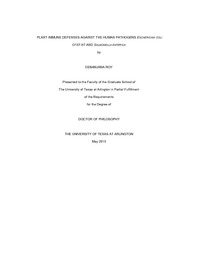| dc.description.abstract | Several pathogenic and non-pathogenic microorganisms reside on plant leaf surfaces while bacteria being the most abundant of them all. Often bacteria not only use the plant leaf surface as their habitat but also penetrate through stomatal pore on leaf epidermis to survive in the plant's intercellular space also known as the apoplast. To fight against infection caused by bacteria plants rely on their innate immunity system which consists of pathogen-triggered immunity (PTI) and effector-triggered immunity (ETI). PTI is considered to be the first line of defense response and it is effective against a broad range of pathogens. Nonetheless, some microbial species are able to overcome and /or avoid plant defenses and colonize the apoplast. In particular, there have been frequent cases of association of human pathogens, such as Escherichia coli O157:H7 and Salmonella enterica serovar Typhimurium SL1344, with fresh fruits and vegetables that can cause illness or death among consumers who eat contaminated produce. The economic consequences of produce-associated outbreaks including medical costs, damage control cost, produce recall cost, and production time are substantial. At this point the underlying mechanism of this intriguing phenomenon of human pathogens and plant interaction is not well understood and this is the area of my study. In the first chapter of my dissertation I introduce the newly developed field of human pathogen on plants following innate immunity of plant against human pathogens in the second chapter. In the third chapter, the defense pathway(s) playing significant role in diminishing human pathogens populations in plant tissue is explored. Laying emphasis on these puzzling areas of plant pathology, my study will contribute to understanding the initial contamination process, effect of environmental factors on human pathogen infection of plants, and important defense pathway(s) in plants which are paramount in preventing food borne diseases. | en_US |

